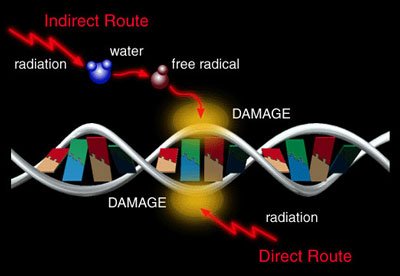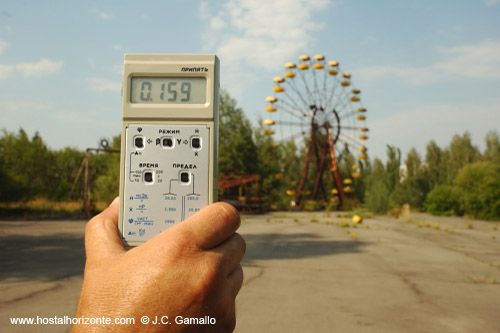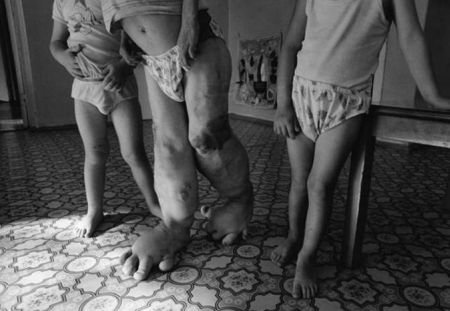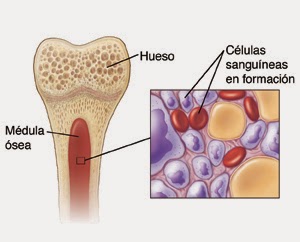How does radiation affect our body?
The tragic chain of events that began with an earthquake of enormous magnitude, which was followed by a tsunami that devastated part of the northern part of Japan and, in turn, damaged the cooling systems of the reactors of the Fukushima nuclear power plant, It has resulted in thousands of victims and missing and a nuclear crisis: the recent explosions in the reactors of the Fukushima nuclear power plant have caused the release of radiation to the atmosphere.
While the Japanese authorities recommend measures to protect themselves against radiation, the world population and especially the Japanese one wonders what consequences could have for the health the exposure to the radiation released.

How does radiation cause damage to the human body?
The radioactivity occurs as a consequence of the disintegration of the nuclei of the atoms. Thus, for example, the main radioactive material present in the Fukushima power station is uranium (one of them also has plutonium). When this element disintegrates it releases a powerful radiation (energy) and radioactive cesium and iodine are formed which, in turn, decompose into other elements, progressively losing their radioactive capacity.
The escapes of radiation that have been given to the atmosphere are mainly due to cesium and iodine (uranium and plutonium under current conditions are quite well protected and it is difficult to be released to the outside).
Due to this disintegration, different types of radiation and particles are released that can modify or alter the molecules of our own cells affecting them and causing an alteration in their normal functioning.
If the radiation dose is small, the cells (by themselves) are able to repair the damage caused or to replace the dead cells as a result of the radiation. But if the dose is high, the destruction of a large number of cells and/or the induction of cancers occurs as a result of irreversible damage to DNA (mutations) that have not been able to be repaired. That is, the cells have different repair strategies against radiation until, after a certain dose, they are not able to repair all the damage caused.

What factors determine the risk to health?
The two main parameters to assess the risk of radiation are the dose and the time of exposure.
Radiation doses are measured well in sievert (Sv) or in rem (100 rem equals 1 sievert) and the higher this dose, the greater the probability of getting sick or dying as a result of radiation.
The other important factor is the time since a continuous exposure to radiation whose dosage is, in principle, low can also cause significant damage to health.
In general, the human body tolerates better low doses spread over time than a high dose at a specific time, because the cellular strategies to repair the damage in the latter case are overwhelming.
.jpg)
What risk exists for health according to the dose of radiation received?
To estimate the risk to health that a certain radiation can cause, it is essential to assess it in perspective.
All of us are continuously exposed to radiation, in fact, in a month we receive on average a dose of 0.3 millisieverts (mSV) or 0.03 rem.
When we get a chest x-ray, for example, we are receiving an average radiation of 0.1 mSv. In general, the human body has practically no direct health effects from radiation up to 1,000 mSV.
From the 1,000 mSV the first and main symptoms begin to appear as a result of radiation poisoning: nausea.
With 2000-3000 mSV in addition to nausea, vomiting, hair loss and diarrhea occur in some affected.
With 5,000 mSV all people are affected by the above symptoms and signs. With 8,000 msV they intensify and hemorrhages and infections may appear.
The odds of death among people exposed to unique radiation doses of 3,000 and 4,000 mSV is 50%, with doses around 10,000 mSV death occur safely after a few weeks and 20,000 mSv in hours or days.
The direct effects on health discussed above that cause radiation must also take into account the indirect and long-term effect on the increase in the frequency of cancers as a result of genetic damage.
This increase in the frequency of cancer is probabilistic, the higher the dose of radiation received, the greater the risk of cancer. For example, with an exposure of 1,000 mSV there is a 5% increase in the risk of cancer years later in the exposed population. If the exposure rises to 3,000 mSV there will be an increase in cancer risk of 42%.

Which are the most vulnerable organs to radiation?
In general, those organs or tissues more vulnerable to radiation are those in which the cells are multiplying very actively.
For that reason, the bone marrow (where blood cells, platelets, and white blood cells are made), the digestive system and reproductive systems can be seriously affected with sufficient doses of radiation. The damage to the bone marrow causes a partial or total reduction of the manufactured cells, which leads to hemorrhages, infections, and anemia.
On the other hand, the damage to the digestive system causes nausea, vomiting, and diarrhea. Finally, radiation in the reproductive systems can trigger partial or total sterility by damage to the precursor cells of the ovules and sperm, as well as abortions or malformations in fetuses.

What is more dangerous, external exposure to radiation or the incorporation of radioactive material into the body?
External exposure to radiation, provided that it is at low doses and in a short period of time, is usually of lesser risk since radiation is stopped when the person moves away from the radioactive source.
However, the incorporation into the body of radioactive material (either by ingestion or by breathing) can be really dangerous since, although emitting low doses of radiation this exposure is prolonged and, depending on the radioactive element, can last days, weeks, months or years, which can cause a total accumulation of very high radiation.
Why are iodine pills recommended and washed frequently and dispose of clothes exposed to radiation?
The thyroid gland, to produce the hormone thyroxine, needs to take in iodine. We acquire this iodine from normal through food.
Because one of the elements released at the Fukushima nuclear power plant is radioactive iodine, there is a likelihood that people will incorporate it into their thyroid through contaminated food or by inhalation. For this reason, the authorities have recommended the intake of iodine pills, because this way the thyroid is saturated with this element and it no longer captures iodine for weeks (reducing the risk of radioactive iodine uptake in the thyroid and, therefore, the risk of cancer associated with this gland).
Of course, this measure does not protect against external exposure to radiation. On the other hand, recommendations such as washing thoroughly and discarding clothes after going outside are done to eliminate radioactive particles in suspension in the atmosphere that may have deposited on clothing or skin.
Can people exposed to radiation transmit radiation to other people?
In principle no, people who have been exposed to radiation do not transmit radiation to other people, it is not contagious. However, if that person has incorporated radioactive particles into his body or has them on his skin or clothes (radioactively contaminated) they will continue to emit radiation that can affect people around (especially children and pregnant women).
What is the risk to health from exposure to radiation levels in and around Fukushima?
On March 12, at the Fukushima nuclear power plant, 1 mSV per hour was detected, on the 15th it reached a maximum level of 400 mSv / h (with 4,000 mSv for brief minutes) and today, the levels have decreased at 279.4 mSv / h.
These levels of radiation are not initially lethal, but if workers at the nuclear power plant were exposed for several hours or days to these radiation levels (even with protective suits) they could start to develop radiation poisoning with nausea, vomiting, etc. . and even end up causing death.
To avoid that, all workers were evacuated except for 50 people who decided to stay at the nuclear power plant to cool the reactors plus 130 firefighters, technicians and soldiers who later volunteered to help.
These 180 heroes face a prolonged exposure of radiation that can cause them radioactive poisoning, with a risk of death difficult to specify (it will depend on the time in which they are exposed to the radioactive source, if they limit the exposure to a short period of time they can work in a relatively safe way) and, in all likelihood, will significantly increase their risk of cancer over the years.
The population immediately closest to the nuclear power station has already been evacuated, as far as the nearest population currently, which is 30 kilometers away, the Japanese Minister of Science has commented that the radiation levels there are at 0, 17 mSV / h.
They are not high enough to cause radiation poisoning, but they are high enough to increase the risk of cancer in the population of the area. Even so, because the radiation levels are considerably attenuated as the distance from the nuclear power plant increases, it is expected that health effects caused beyond 30 kilometers are imperceptible or slight increases in the risks of cancer long-term.
thanks for reading my publication, I say goodbye.
For more information visit this page.
http://www.rtve.es/noticias/20110318/asi-afecta-radiacion-liberada-cuerpo-humano/417910.shtml
Atte.
@jorge150785